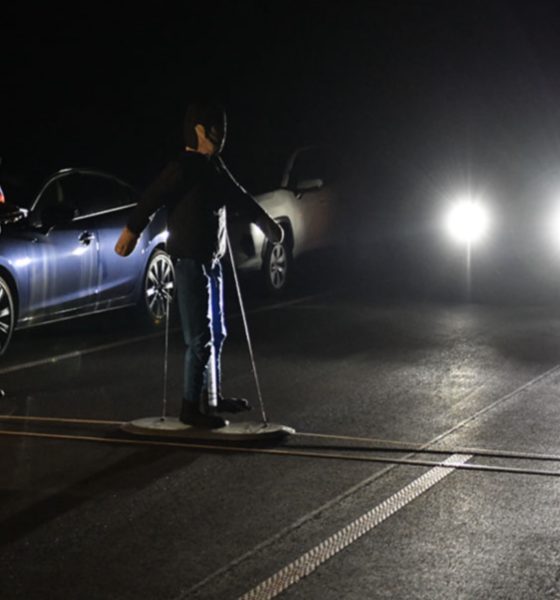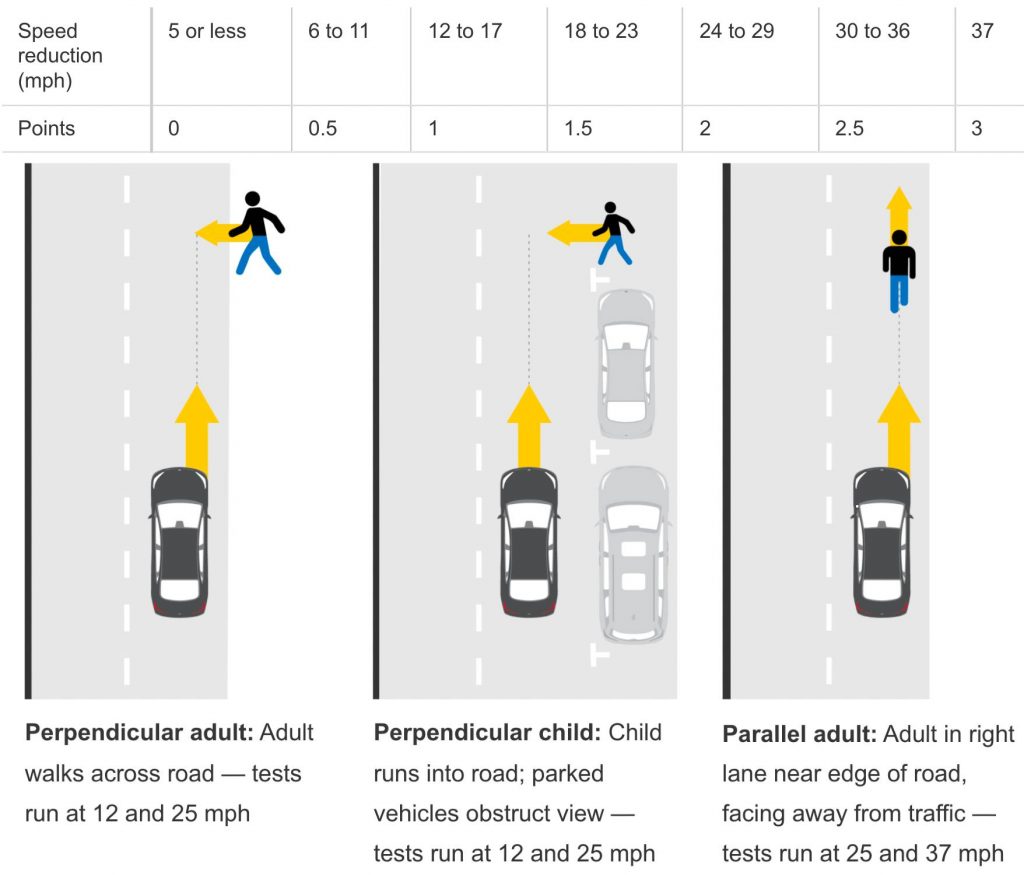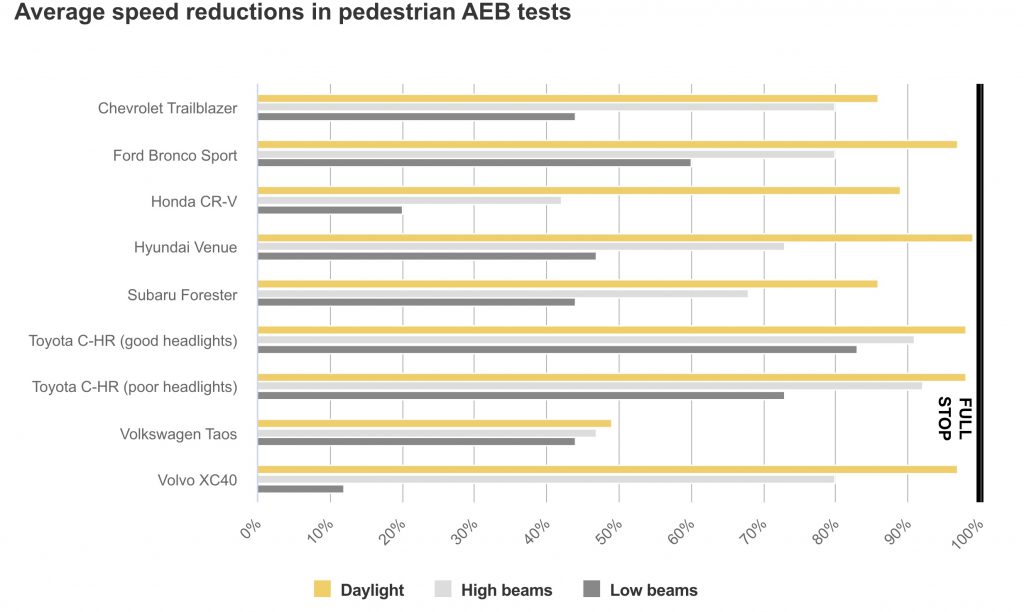

News
IIHS to develop nighttime AEB evaluation after study finds emergency braking systems make no difference in the dark
A study by the Insurance Institute for Highway Safety (IIHS) found that pedestrian crash rates were lower when vehicles were equipped with pedestrian automatic emergency braking (AEB) systems. However, the agency’s study also revealed that AEB systems practically made no difference in pedestrian crashes that occurred at night.
“This is the first real-world study of pedestrian AEB to cover a broad range of manufacturers, and it proves the technology is eliminating crashes,” says Jessica Cicchino, IIHS vice president of research. “Unfortunately, it also shows these systems are much less effective in the dark, where three-quarters of fatal pedestrian crashes happen.”
The AEB System Study
Cicchino, the IIHS study’s author, looked at nearly 1,500 police-reported crashes involving 2017-2020 model-year vehicles from different manufacturers to determine the impact AEB systems made in pedestrian crashes. The study accounts for the quality of the vehicle’s headlights, along with the driver’s age, gender, and other demographic factors.
The study found that pedestrian crash rates of all severities were 27% lower when vehicles were equipped with AEB systems. Injury crash rates were 30% lower. However, the study also found that AEB systems made no difference in tests conducted in “unlighted areas.”
Cicchino made the discovery among a subset of 650 crashes with more detailed information about lighting conditions, speed limit, and crash configuration. The more detailed data revealed that AEB systems reduced the odds of pedestrian crashes by 32% in daylight and 33% in areas with artificial lighting, during dusk or dawn and nighttime.
Nighttime AEB Evaluation Tests
The manager of active safety testing at IIHS, David Taylor, and his team have already conducted some research tests to design the planned nighttime pedestrian AEB evaluation. Eight small SUVs from eight different manufacturers were put through the standard vehicle-to-pedestrian evaluation in complete darkness.
IIHS tested a 2019 Subaru Forester, 2019 Volvo XC40, 2020 Honda CR-V, 2020 Hyundai Venue, 2021 Chevrolet Trailblazer, 2021 Ford Bronco Sport, 2021 Toyota C-HR, and 2022 Volkswagen Taos. Each vehicle went through the evaluation twice.
Current Vehicle-to-Pedestrian Evaluation
The IIHS vehicle-to-pedestrian evaluation is a 6-point scale, as seen below. The test consists of several scenarios where adult and child-like dummies “walk” perpendicular or parallel to the vehicle at varying speeds. Total points for perpendicular scenarios are weighted at 70%, while points from the parallel scenario are weighted at 30%.
During five test runs, vehicles were awarded points based on their average speed reduction. An additional point is awarded in the 37 mph parallel scenario to cars that provide the driver a warning at least 2.1 seconds before impact.

Nighttime AEB Evaluation Test Results
The vehicles the IIHS chose for the test included cars that used single cameras, dual cameras, single camera and radar, and radar only configurations. The test also had vehicles that already took the vehicle-to-pedestrian front crash prevention evaluation and earned ratings ranging from superior, advanced, and basic.

Except for the radar-only Taos, all the vehicles’ performances declined in the dark, dropping some of their ratings from superior to advanced when using high beams and superior to basic when using low beams. The Taos received essentially the same nighttime tests scores compared to daytime evaluations. However, the IIHS noted that the Taos was also the worst performer during the daytime tests.
The best performers in the nighttime tests were the 2021 Ford Bronco Sport and 2021 Toyota C-HR. Both vehicles use a combination of cameras and radar.
“The better-performing systems are too new to be included in our study of real-world crashes,” noted Aylor. “This may indicate that some manufacturers are already improving the nighttime performance of their pedestrian AEB systems.”
The Teslarati team would appreciate hearing from you. If you have any tips, reach out to me at maria@teslarati.com or via Twitter @Writer_01001101.

Elon Musk
Starlink passes 9 million active customers just weeks after hitting 8 million
The milestone highlights the accelerating growth of Starlink, which has now been adding over 20,000 new users per day.

SpaceX’s Starlink satellite internet service has continued its rapid global expansion, surpassing 9 million active customers just weeks after crossing the 8 million mark.
The milestone highlights the accelerating growth of Starlink, which has now been adding over 20,000 new users per day.
9 million customers
In a post on X, SpaceX stated that Starlink now serves over 9 million active users across 155 countries, territories, and markets. The company reached 8 million customers in early November, meaning it added roughly 1 million subscribers in under seven weeks, or about 21,275 new users on average per day.
“Starlink is connecting more than 9M active customers with high-speed internet across 155 countries, territories, and many other markets,” Starlink wrote in a post on its official X account. SpaceX President Gwynne Shotwell also celebrated the milestone on X. “A huge thank you to all of our customers and congrats to the Starlink team for such an incredible product,” she wrote.
That growth rate reflects both rising demand for broadband in underserved regions and Starlink’s expanding satellite constellation, which now includes more than 9,000 low-Earth-orbit satellites designed to deliver high-speed, low-latency internet worldwide.
Starlink’s momentum
Starlink’s momentum has been building up. SpaceX reported 4.6 million Starlink customers in December 2024, followed by 7 million by August 2025, and 8 million customers in November. Independent data also suggests Starlink usage is rising sharply, with Cloudflare reporting that global web traffic from Starlink users more than doubled in 2025, as noted in an Insider report.
Starlink’s momentum is increasingly tied to SpaceX’s broader financial outlook. Elon Musk has said the satellite network is “by far” the company’s largest revenue driver, and reports suggest SpaceX may be positioning itself for an initial public offering as soon as next year, with valuations estimated as high as $1.5 trillion. Musk has also suggested in the past that Starlink could have its own IPO in the future.
News
NVIDIA Director of Robotics: Tesla FSD v14 is the first AI to pass the “Physical Turing Test”
After testing FSD v14, Fan stated that his experience with FSD felt magical at first, but it soon started to feel like a routine.

NVIDIA Director of Robotics Jim Fan has praised Tesla’s Full Self-Driving (Supervised) v14 as the first AI to pass what he described as a “Physical Turing Test.”
After testing FSD v14, Fan stated that his experience with FSD felt magical at first, but it soon started to feel like a routine. And just like smartphones today, removing it now would “actively hurt.”
Jim Fan’s hands-on FSD v14 impressions
Fan, a leading researcher in embodied AI who is currently solving Physical AI at NVIDIA and spearheading the company’s Project GR00T initiative, noted that he actually was late to the Tesla game. He was, however, one of the first to try out FSD v14.
“I was very late to own a Tesla but among the earliest to try out FSD v14. It’s perhaps the first time I experience an AI that passes the Physical Turing Test: after a long day at work, you press a button, lay back, and couldn’t tell if a neural net or a human drove you home,” Fan wrote in a post on X.
Fan added: “Despite knowing exactly how robot learning works, I still find it magical watching the steering wheel turn by itself. First it feels surreal, next it becomes routine. Then, like the smartphone, taking it away actively hurts. This is how humanity gets rewired and glued to god-like technologies.”
The Physical Turing Test
The original Turing Test was conceived by Alan Turing in 1950, and it was aimed at determining if a machine could exhibit behavior that is equivalent to or indistinguishable from a human. By focusing on text-based conversations, the original Turing Test set a high bar for natural language processing and machine learning.
This test has been passed by today’s large language models. However, the capability to converse in a humanlike manner is a completely different challenge from performing real-world problem-solving or physical interactions. Thus, Fan introduced the Physical Turing Test, which challenges AI systems to demonstrate intelligence through physical actions.
Based on Fan’s comments, Tesla has demonstrated these intelligent physical actions with FSD v14. Elon Musk agreed with the NVIDIA executive, stating in a post on X that with FSD v14, “you can sense the sentience maturing.” Musk also praised Tesla AI, calling it the best “real-world AI” today.
News
Tesla AI team burns the Christmas midnight oil by releasing FSD v14.2.2.1
The update was released just a day after FSD v14.2.2 started rolling out to customers.

Tesla is burning the midnight oil this Christmas, with the Tesla AI team quietly rolling out Full Self-Driving (Supervised) v14.2.2.1 just a day after FSD v14.2.2 started rolling out to customers.
Tesla owner shares insights on FSD v14.2.2.1
Longtime Tesla owner and FSD tester @BLKMDL3 shared some insights following several drives with FSD v14.2.2.1 in rainy Los Angeles conditions with standing water and faded lane lines. He reported zero steering hesitation or stutter, confident lane changes, and maneuvers executed with precision that evoked the performance of Tesla’s driverless Robotaxis in Austin.
Parking performance impressed, with most spots nailed perfectly, including tight, sharp turns, in single attempts without shaky steering. One minor offset happened only due to another vehicle that was parked over the line, which FSD accommodated by a few extra inches. In rain that typically erases road markings, FSD visualized lanes and turn lines better than humans, positioning itself flawlessly when entering new streets as well.
“Took it up a dark, wet, and twisty canyon road up and down the hill tonight and it went very well as to be expected. Stayed centered in the lane, kept speed well and gives a confidence inspiring steering feel where it handles these curvy roads better than the majority of human drivers,” the Tesla owner wrote in a post on X.
Tesla’s FSD v14.2.2 update
Just a day before FSD v14.2.2.1’s release, Tesla rolled out FSD v14.2.2, which was focused on smoother real-world performance, better obstacle awareness, and precise end-of-trip routing. According to the update’s release notes, FSD v14.2.2 upgrades the vision encoder neural network with higher resolution features, enhancing detection of emergency vehicles, road obstacles, and human gestures.
New Arrival Options also allowed users to select preferred drop-off styles, such as Parking Lot, Street, Driveway, Parking Garage, or Curbside, with the navigation pin automatically adjusting to the ideal spot. Other refinements include pulling over for emergency vehicles, real-time vision-based detours for blocked roads, improved gate and debris handling, and Speed Profiles for customized driving styles.








